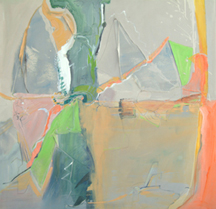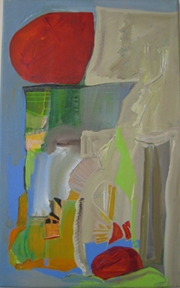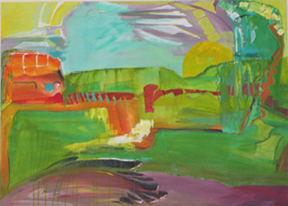Artist and educator Ande Lister is living proof that growing up in a small town is no excuse for art apathy as an adult. The Springfield native is the daughter of a minister, and she was raised in several small Illinois communities. “Growing up as I did, our access to arts of all types was limited. I don’t remember ever having an ’art teacher’ in any of the elementary or high schools I attended. My parents and extended family encouraged and appreciated my efforts in these areas, though. So, perhaps in that way, I was encouraged to pursue my interest in art. But the longer I pursue the making of art, the more I’m convinced that, for me, visual art is a language of expression.”
Lister earned an undergraduate degree in elementary education with a minor in art education and a master’s degree in art education from the University of Illinois. Putting her degrees to use, she began her teaching career in District 150. “I taught second grade at what’s now Lindberg Middle School-the former Kellar West-and just always loved teaching. Then, we moved to Gainesville, Fla., for several years before returning to Peoria, and I devoted my time to raising our children. But I always expected to return to teaching.”
 She directed her passion into art workshops she conducted through her church, First United Methodist. “About this time, Barb Garber approached me about the art educator position at Lakeview Museum Preschool. Barb’s sister, Beverly Kats, was directing that program, and I held that position for seven years. During that time, I also taught art for two years at PALS elementary school.”
She directed her passion into art workshops she conducted through her church, First United Methodist. “About this time, Barb Garber approached me about the art educator position at Lakeview Museum Preschool. Barb’s sister, Beverly Kats, was directing that program, and I held that position for seven years. During that time, I also taught art for two years at PALS elementary school.”
But painting-for herself and others-has also been a constant over the years. “Following the death of my mother, I discovered painting provided a place and time to confront my grief. But beyond that, I discovered that the more I painted, the more necessary it became. Painting continues to restore me somehow. In a way, the process of painting empties a place in my sometimes-overfilled mind and soul. At any rate, I felt compelled to continue painting.”
And continue she has, selling her work for the past 18 years. She has a studio in her home, where she works on smaller pieces, and a studio at the Contemporary Art Center, where she’s worked since 1997. “Art production often takes place in solitude,” Lister explained. “While this is necessary, it can also be a bit lonely. The space at the CAC offers times of solitude but also access to others going through similar experiences and artistic challenges. I’ve learned a lot from and have been nurtured by my fellow CAC artists. I think the artists’ studio facilities at the CAC are a wonderful, perhaps undiscovered, asset of Peoria’s arts community. I wish more people would take advantage of the opportunity to visit these living, working artist studios. It’s a great place to see the creative process in action and encompasses a wide range of artistic style and mediums.”
Lister describes herself as an intuitive painter. “I started painting with watercolors, and, like so many artists, my early paintings are representational works-floral, landscape, still life, and so forth. But I’ve always been fascinated by the color, line, and form of abstract paintings. And so, as soon as I had some mastery of the medium, I longed to explore abstraction. I distinctly remember the ’light bulb moment’ when I first grasped the concept of applying this intuitive process in the development of abstract work. It happened at the Art Guild under the direction of artist Ann Coulter. Working with pastels rather than paint, we were developing our ideas from photographs. Ann was working abstractly at the time, and her guidance helped me make the transition from drawing what my eyes see to responding to the composition emerging on the paper or canvas. It continues to be an exciting and rewarding way of working for me.”
 Because her paintings deal with abstraction and her process is intuitive, Lister said she doesn’t visualize the work before she begins. “In fact, I find that if I begin to interpret the work too early in the painting process, it becomes a barrier to a meaningful and successfully completed composition. In other words, the more open I remain to responding to the mark and form as it occurs, the stronger the work at completion. In the end, the subject matter of the work becomes clear to me. This is a difficult process to explain, but I often find those who look at my paintings, while bringing their own perceptions, share common responses and understandings about a particular painting.”
Because her paintings deal with abstraction and her process is intuitive, Lister said she doesn’t visualize the work before she begins. “In fact, I find that if I begin to interpret the work too early in the painting process, it becomes a barrier to a meaningful and successfully completed composition. In other words, the more open I remain to responding to the mark and form as it occurs, the stronger the work at completion. In the end, the subject matter of the work becomes clear to me. This is a difficult process to explain, but I often find those who look at my paintings, while bringing their own perceptions, share common responses and understandings about a particular painting.”
Lister has once again found an outlet for both her love of art and teaching-Arts Place. “Arts Place is an outgrowth of two aspects of First United Methodist Church. Our church is home to several artists and has a thriving Fine Arts Ministry Team. We also have been involved in a successful partnership with Irving Primary School for the past 10 years. These assets and opportunities merged in the idea of an after-school arts enrichment program we named Arts Place.”
The program serves third and fourth grade Irving students, she said. “Irving Primary students benefit from a fabulous art teacher, Connie Carroll, but as we all know, public school resources, materials, and opportunities are limited by funding, space, and time. With a gift from Ellie Foster and the talents and willingness of our congregation, we’re able to provide field trips to museums, galleries, studios, and performances.”
The program also provides professional instruction in the arts and high-quality materials so students can engage their creative spirits in the process of art making, Lister explained. “Over the years, Bradley University students have provided excellent instruction in ceramics. This past fall, in collaboration with the Art Guild and Ann Conver, students learned about photography. We share culinary arts, poetry, and theater, in addition to the many visual arts opportunities and classes. One particular aspect of Arts Place is especially noteworthy and valuable. Week after week, dozens of caring adult volunteers arrive to assist with classes, snacks, and transportation needs. During this time, they also encourage, laugh with, and listen to the children and to each other. It all works together to provide a warm and nurturing environment-a very good ’place’ to be and grow.”
The children mentored through Arts Place make all of the efforts worthwhile, she said. “Standing in front of an easel for the first time, one third grader exclaimed, ’I didn’t know I was an artist until today!’ As an artist, I know that experiencing the arts and making art informs my own awareness of myself, whom I am, and who I’m meant to be. As a teacher, I believe a child’s positive and varied experiences expand self-awareness, vocabulary, and the capacity for learning and relating to the world that waits for her leadership and contribution.”
Lister herself has benefited from many mentors throughout her career. “Carol Quell taught the first watercolor class I took at Lakeview and has become a dear friend and fellow Arts Place teacher. My professors and fellow graduate students encouraged me to keep growing and working as an artist/educator while keeping up with a busy family. My personal faith in relationship to my vocation has always been of utmost importance to me. Along with guidance from my parents and extended church family, authors such as Madeline L’Engle-who speaks directly to questions of creativity in the context of our vocation as artists-have been a great resource for clarifying my faith as it relates to and informs my art and my work. And then, I’m always influenced by artists whose work I’m privileged to come face to face with. This includes the timeless and masterful artists of the past, but also the inspired artists working in my own community.”
Along with Arts Place, Lister is involved with many other community art initiatives. “I participate in the organization of the Annual Fine Arts Exhibit, hosted by First United Methodist Church. It just concluded it’s 20th year and exhibited the works of 60 visual artists from the Peoria region. I’m also excited about my role on the board of ArtsPartners and as an advocate for the outstanding arts organizations that bless our community. I’m confident that the role of the arts and a growing arts district are vital to the revitalization of Peoria’s downtown and the health and livability of our region,” she said.
 The best part of her dual careers has been the opportunity to meld her love of art and teaching and to have had the time to devote to a family and volunteer activities, as well. “I owe that to a husband who’s an encourager as well as a good provider. It’s pretty tough to make a living as an artist and quite challenging to teach full time and still find time and energy to grow and produce as an artist. I truly admire so many who do both and do it well. The challenge for me is to continue to work and act creatively in both my art and in my relationships with those who are working toward a vision of wholeness and shalom in our community. Someone said to me, ’I don’t know if you see the glass as half full or half empty, but you seem to feel that you must fill it!’ I do believe I have a role to play in the filling of our collective cup, just as we all do.”
The best part of her dual careers has been the opportunity to meld her love of art and teaching and to have had the time to devote to a family and volunteer activities, as well. “I owe that to a husband who’s an encourager as well as a good provider. It’s pretty tough to make a living as an artist and quite challenging to teach full time and still find time and energy to grow and produce as an artist. I truly admire so many who do both and do it well. The challenge for me is to continue to work and act creatively in both my art and in my relationships with those who are working toward a vision of wholeness and shalom in our community. Someone said to me, ’I don’t know if you see the glass as half full or half empty, but you seem to feel that you must fill it!’ I do believe I have a role to play in the filling of our collective cup, just as we all do.”
As far as the future goes, Lister said she’s contemplating additional study. “I really like the challenge and excitement of school and learning. I might be interested in pursuing an MFA; I always paint more when I have an assignment and deadline. I also expect to continue to be involved with the arts community and the work of Arts Place.”
Lister isn’t concerned about having concrete action plans, however. “I’ve had the great fortune to be able to respond to the opportunities that have presented themselves along the way. Maybe a bit like painting abstractly, I really don’t have a finished canvas of the future in my mind. I’ll just try to stay faithful to the process, open to the possibilities, and trust that the result will be meaningful in some way to those who come face to face with the composition.” AA!


